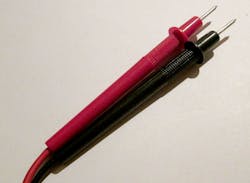Tip of the Week: The Value of One-Hand Measurements
What’s the correct way to hold your test leads when working on live circuits? Answer: Don’t hold them. The trick to that answer is you don’t hold both leads.
Using one hand (place the other behind you or in your pocket, or use it to hold the meter), clip a lead onto the first measurement point (preferably not the one that’s hot). Then pick up the other lead and hold it (or clip it) to the other reference point.
Why do it this way? Draw out the current paths, and you can see why. By holding only one lead, you just about eliminate the chance of current flow across your heart. If you’re wearing the correct PPE and doing everything else right, this method may seem unnecessary. But it does add yet another layer of protection when making those connections.
It has another advantage too, and that comes into play when you disconnect those test leads. If you use the one-hand approach consistently whenever using a two-lead contact-type meter (e.g., a DMM) you eliminate a mistake that can lead to arc blast.
What is that mistake? Disconnecting and withdrawing the test leads simultaneously. There’s always a small arc when you disconnect. If you disconnect both leads at the same time, you’re probably striking two small arcs at the same time. Each arc creates a small ionization field.
If these overlap, you create an ionization path between the two measurement points. This can result in flashover and/or arc flash. That alone can produce serious injury. But if enough heat is generated during this event, the result may be an arc blast.
Whenever possible, hold only one test lead at a time.
About the Author

Mark Lamendola
Mark is an expert in maintenance management, having racked up an impressive track record during his time working in the field. He also has extensive knowledge of, and practical expertise with, the National Electrical Code (NEC). Through his consulting business, he provides articles and training materials on electrical topics, specializing in making difficult subjects easy to understand and focusing on the practical aspects of electrical work.
Prior to starting his own business, Mark served as the Technical Editor on EC&M for six years, worked three years in nuclear maintenance, six years as a contract project engineer/project manager, three years as a systems engineer, and three years in plant maintenance management.
Mark earned an AAS degree from Rock Valley College, a BSEET from Columbia Pacific University, and an MBA from Lake Erie College. He’s also completed several related certifications over the years and even was formerly licensed as a Master Electrician. He is a Senior Member of the IEEE and past Chairman of the Kansas City Chapters of both the IEEE and the IEEE Computer Society. Mark also served as the program director for, a board member of, and webmaster of, the Midwest Chapter of the 7x24 Exchange. He has also held memberships with the following organizations: NETA, NFPA, International Association of Webmasters, and Institute of Certified Professional Managers.
